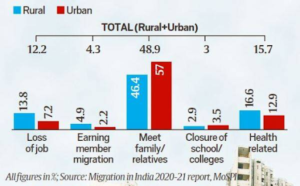In news– The Ministry of Statistics and Programme Implementation (MoSPI) has released the Migration in India report 2020-21 recently.
Key findings of the report-
- The ‘Migration in India’ report, which is based on first-time collection of additional data during the annual round of Periodic Labour Force Survey for July 2020-June 2021, separates the categories of ‘temporary visitors’ and ‘migrants’.
- While ‘temporary visitors’ have been defined as the ones who arrived in households after March 2020 and stayed continuously for a period of 15 days or more but less than 6 months.
- ‘Migrants’ have been defined as those, for whom the last usual place of residence, any time in the past, is different from the present place of enumeration.
- As per the report, after the onset of the Covid-19 pandemic in March 2020, 0.7 per cent of the country’s population was recorded as a ‘temporary visitor’ across households during the July 2020-June 2021 period.
- A total of 48.9 percent of the temporary visitors moved to meet family/relatives/friends between July 2020 to June 2021, while 15.7 per cent of such temporary visitors moved for health related reasons and 12.2 per cent moved due to loss of job/closure of unit/lack of employment opportunities.
- 0.7 per cent of the country’s population moved during July 2020-June 2021 as temporary visitors in the households.
- The temporary visits were due to a variety of reasons as enlisted in the survey.

- Taking the country’s total population to be 121.08 crore (Census 2011), 0.7 per cent would imply to be about 85 lakh ‘temporary visitors’ in the households.
- The all-India migration rate was 28.9 per cent for July 2020-June 2021, with 26.5 percent migration rate in rural areas and 34.9 per cent in urban areas.
- It has also revealed that females recorded a higher share of migration rate of 47.9 percent, with 48 per cent in rural areas and 47.8 per cent in urban areas.
- The migration rate for males was seen at 10.7 per cent, with 5.9 per cent in rural areas and 22.5 per cent in urban areas.
- Among females, the highest level of migration rate was seen for marriage, while for males it was for employment.
Note:
- Usual Place of Residence (UPR) of a person is the place (village/town) where the person has been staying continuously for at least six months. Even if a person was not staying in the village/town continuously for six but was found to be staying there during the survey with intention to stay there continuously for six months or more then that place was his/her UPR.
- Migrant: A household member whose last usual place of residence, any time in the past, was different from the present place of enumeration was considered as a migrant member in a household.
- Migration rate: Migration rate for any category of person (say, for rural or urban, male or female), is the percentage of migrants belonging to that category of persons.
Source: The Indian Express
















